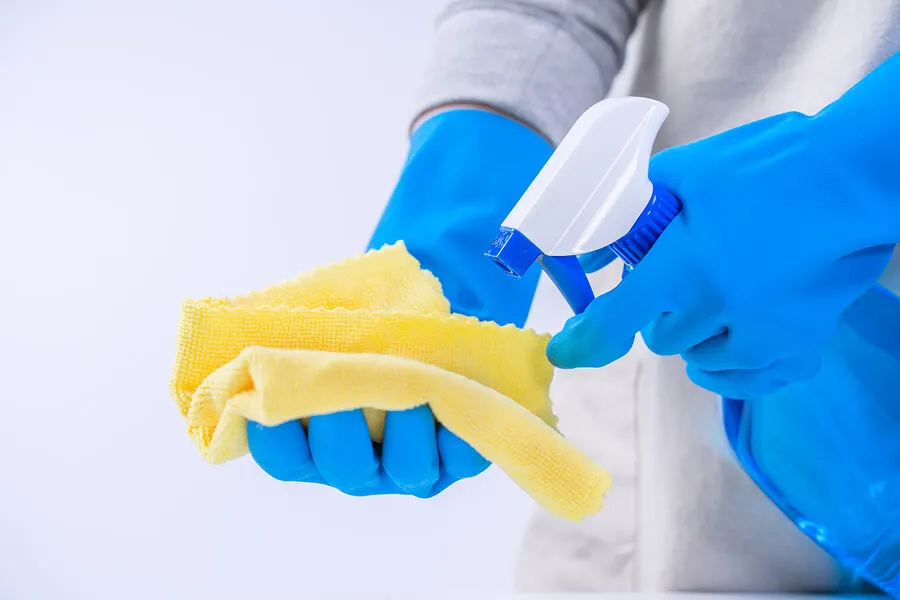Tadelakt: Stylish Cement Effect Paint

Tadelakt is faithful proof that the old always comes back in style at some point in time. In this case, we’ll be introducing you to this unique decoration technique that, despite being used for many years, is becoming more and more popular.
Next, we will review what this ancient practice is about and its origins. You will know how to apply it and what are its pros and cons.
What is “tadelakt”?
Also known as “cement effect paint” or“microcement,” this style has a strong inspiration in the Moroccan past. It’s a coating or patina that’s applied on the walls and achieves a cement-like appearance, in addition to having a very particular texture.
The term is Arabic and derives from the verb dalaka, which means “to polish or rub.” This is precisely the basis of this technique, which is very common in Morocco and has gradually crossed borders.
Originally, it was used to protect walls from humidity, as it has a powerful waterproofing effect. It was also used for the manufacture of ceramic and Moroccan pieces.
However, tadelakt is formed with lime and natural pigments. It’s then polished with pebbles to achieve the smooth appearance of its finish.
Today, marble dust and other mineral powders are added to this lime. A trowel is used to even out the mixture.
It has the experience of a rounded and smooth finish. It’s both decorative and impermeable at the same time, as well as fungicidal. This’s why it is mainly used in bathrooms and kitchens.
Its most current predecessor is chalk paint, whose finish resembles velvet. Let’s take a look at the applications of tadelakt.

How and where can “tadelakt” be used?
This is a very versatile technique that can be applied in different rooms of the house, although the most common spaces are the bathroom and the kitchen. It’s usually used to cover floors, walls, and even furniture, such as countertops and countertops. Likewise, it’s suitable for both interior and exterior use.
Remember that this is a rather rustic stucco look, so its rounded and imperfect finish looks great. Originally, it was rubbed with a pebble, so this curved effect was achieved in a more accentuated way. Nowadays, a trowel is used, although the rounded finish persists.
As for its application, it’s fair to say that it requires skilled labor or at least some practice. Everything will depend on the place you want to coat. Perhaps you can start doing it yourself on smaller surfaces until you get the hang of the technique.
We think you may also enjoy reading this article: Challenge Your Creativity with These 7 Original Ideas to Decorate Bottles
How is it applied?
This product comes ready to use, and you only need to add the amount of water indicated by the manufacturer. Here are some of the considerations you should take into account before applying tadelakt:
- Clean the surface thoroughly before the first coat. If you notice any holes, be sure to cover them.
- It’s recommended to prime the surface before applying the first coat so that the product adheres well.
- Before applying the tadelakt itself, make sure to wet the base.
- When applying the product, apply it with a spatula or trowel with semicircular movements. In this way, you will help the rounded effect sought with this stucco.
- Regarding the drying time, the ideal drying time is 8 to 10 hours.
- The second coat you apply should be thicker than the first one and should be left to dry for the same amount of hours.
- To finish the job, a final coat of wax or black olive oil soap is usually applied. This is done to ensure that the surface is waterproof.
The final treatment should be done every two years to renew its moisture repellent effect.
If you’d like – and to make sure it coats the surfaces well – you can apply more than two coats. The technique isn’t difficult; it just requires time and patience.
You must wait at least 30 days before you can wet the area where this product was applied. To clean the areas with tadelakt, don’t use chemical cleaning products or other abrasive substances, as they can damage it.
In this sense, you’ll only need water and neutral soap to clean the surfaces. Don’t forget to use a soft sponge to avoid damaging it.

Like this article? You may also like to read: Eco-Friendly Decoration: Sustainable Ways To Decorate Your Home
“Tadelakt”: Is it a good idea?
So far, we’ve taken a look at what this increasingly popular decorative technique is all about. However, it’s also important to talk about its advantages and disadvantages.
The positive aspect that we can point out is its hygienic effect. Since it works as a cement, it has an antibacterial effect and is fungicidal due to its lime content.
Likewise, it’s an environmentally friendly type of wall coating.
Another advantage is that it repels moisture. That’s why it’s so widely used in bathrooms and kitchens. You can forget about mold and mildew on ceilings and walls if you use this surface coating. In addition, you can apply dyes, so you can even get other colors apart from cement gray.
Among its cons, we can mention that it requires application by professionals. Also, it needs a long drying time to reach the desired hardness. It’s important to avoid contact with these areas for a while.
Finally, it’s important to mention that it’s not the most budget-friendly material. Perhaps this is the reason why it’s usually applied on small surfaces.
We hope you can use this information to your advantage and that you will be encouraged to innovate your decoration and maybe even try out this unique decoration style!
All cited sources were thoroughly reviewed by our team to ensure their quality, reliability, currency, and validity. The bibliography of this article was considered reliable and of academic or scientific accuracy.
- Macías, B. E. D. (2017, October). Evaluación de la permeabilidad del tadelakt aplicado sobre diferentes materiales base. In Actas del Décimo Congreso Nacional y Segundo Congreso Internacional Hispanoamericano de Historia de la Construcción: Donostia-San Sebastián(pp. 417-426).
- Díaz Macías, B. E. (2018). Adaptación del tadelakt a la región de clima cálido de México empleando cal como material hidrófugo en vivienda de interés social(Doctoral dissertation, Universidad Autónoma de Aguascalientes).
- Penadés Sanz, J. (2015). Análisis y estudio del microcemento(Doctoral dissertation, Universitat Politècnica de València).
- Sebastián, D. S. de Historia de la Construcción.
- Bozzano Ciavaglia, B. (2017). Acabados y revestimientos en el diseño de arquitectura de tierra.
- Espuga Bellafont, J., Gibert Armengol, V., & Berasategui Berasategui, D. (1999). Revoques y estucados: teoría y práctica. Edicions UPC.
This text is provided for informational purposes only and does not replace consultation with a professional. If in doubt, consult your specialist.








